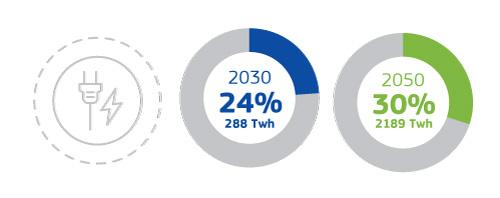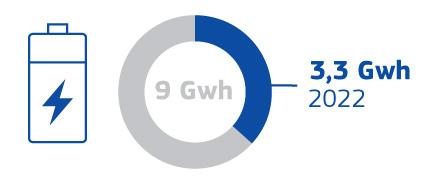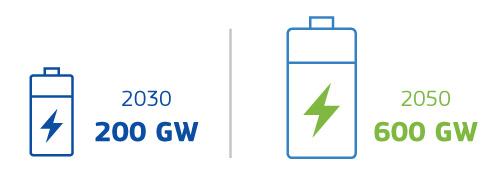Energy storage technologies are crucial for the widespread adoption of renewable energy and achieving the goals of the European Green Deal. They play a transformative role by:
- Balancing Supply and Demand
- Storage allows the grid to store surplus energy generated during high-production periods (like windy or sunny days) and release it during low-production times (like at night or on calm days). This ensures a steady energy supply regardless of renewable generation fluctuations, which is essential for integrating renewables into the energy mix.
- Supporting Grid Stability
- Energy storage helps maintain grid stability by providing rapid-response reserves to balance frequency and voltage. This is essential as renewables, unlike fossil fuels, don’t provide consistent “spinning” reserves to regulate the grid. Stable grids are vital for the reliability of renewable energy sources.
- Reducing Energy Waste
- Without storage, surplus renewable energy would be wasted when production exceeds demand. Storage systems prevent this by capturing excess energy, thereby increasing overall system efficiency and making renewable energy projects more cost-effective. This efficiency is key to making renewables a viable alternative to fossil fuels.
- Enhancing Energy Independence and Resilience
- By enabling more renewable energy integration, storage reduces reliance on imported fossil fuels, strengthens energy independence, and improves resilience against supply shocks, price volatility, and outages. This aligns with the European Green Deal’s goals of energy security and sustainability.
- Enabling Decentralized Energy Systems
- Energy storage allows renewable energy generation to occur closer to consumers, facilitating distributed energy systems and “microgrids” that can operate independently or provide backup during grid outages. Decentralized systems are crucial for a resilient and flexible energy infrastructure.
Chemical Storage: Involves converting electricity into chemical energy, such as hydrogen, which can be stored and later converted back into electricity or used as a fuel. This method is suitable for long-term storage and can help balance seasonal variations in renewable energy production.
Electrochemical Storage: Includes batteries like lithium-ion and flow batteries. These systems store energy through chemical reactions and are ideal for short-to-medium-term storage, making them widely used with solar and wind installations.
Mechanical Storage: Utilizes physical systems to store energy, such as pumped hydro storage (PHS) and flywheels. PHS moves water between reservoirs at different elevations, while flywheels store energy in the form of rotational kinetic energy. These methods are efficient for large-scale and rapid-response storage.
Thermal Storage: Captures and stores heat for later use. This is often paired with solar thermal power to provide energy even when sunlight is unavailable. Thermal storage can also be used in industrial processes and heating systems to improve energy efficiency.
The European Commission published a series of recommendations on energy storage, presenting key facts:
Key facts
System flexibility is particularly needed in the EU’s electricity system, where the share of renewable energy is estimated to reach around 69% by 2030 and 80% by 2050 (from 37% in 2021).

The need for flexibility in the electricity system will increase significantly in all EU countries, reaching 24% (288 TWh) of total EU electricity demand in 2030 and 30% (2 189 TWh) by 2050 across all timescales (from 11% in 2021).

The daily, weekly and monthly flexibility requirements should reach averages of 2.52 TWh/day, 14.6 TWh/week and 41.68 TWh/month by 2050.
On average across the EU, the overall flexibility requirements increase significantly when the share of renewable generation in the electricity system is above 74% of the total installed capacity.

Many European energy-storage markets are growing strongly, with 2.8 GW (3.3 GWh) of utility-scale energy storage newly deployed in 2022, giving an estimated total of more than 9 GWh.

Looking forward, the International Energy Agency (IEA) expects global installed storage capacity to expand by 56% in the next 5 years to reach over 270 GW by 2026.

Different studies have analysed the likely future paths for the deployment of energy storage in the EU. These studies point to more than 200 GW and 600 GW of energy storage capacity by 2030 and 2050 respectively (from roughly 60 GW in 2022, mainly in the form of pumped hydro storage).

